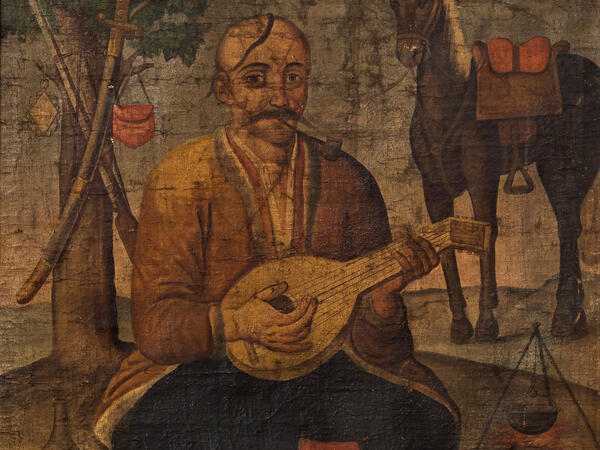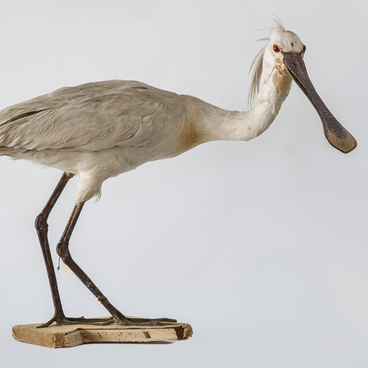The Cossack Mamai is a traditional character in Ukrainian folklore. He first appeared in tales, songs, and jokes, then — in folk theater and painting. Traditionally, he was depicted in the typical clothes worn in Zaporozhye: a velvet ‘zhupan’ (warm overcoat worn by Poles and Ukrainians), blue trousers, and morocco boots. Mamai had an ‘oseledets’ — a long lock of hair left on the otherwise completely shaved head, a long mustache, brown eyes, and ruddy cheeks, that is, he embodied the image of a handsome warrior. Such paintings belonged to ‘lubok’ (a Russian popular print, characterized by simple graphics and narratives derived from popular tales) and were usually used to decorate a Cossack house. They were painted by non-professional artists. Often the images had humorous inscriptions or tales from the life of the Zaporozhians.
The painting ‘Cossack Mamai’ from the collection of the Felitsyn Museum is displayed the exhibition ‘On the borders of the Russian state’. It probably entered the museum from the collection of the Cossack Host Museum of Yekaterinodar. In the early twentieth century, such paintings were very popular in Kuban, but now most of them are lost.
Traditionally, the Cossack Mamai was depicted with three objects: a kobza, a horse, and an oseledets. A kobza, an instrument of the lute family, was most popular among the Cossacks and was often called a symbol of the people’s souls. The Cossacks valued the horse as a loyal friend and a comrade in battle. As for the oseledets, they believed that if a Cossack after death went to hell, it would be possible to pull him out with the help of this long lock of hair. Losing or damaging an oseledets was considered a disgrace. The Cossacks took special care of their hair and believed that the forelock should be protected, “like a maiden protects her braid.” Sometimes it was so long that it was wrapped around the ear or even tucked behind the belt.
In a painting from the museum collection the Cossack Mamai is depicted with a pipe. It was also considered an indispensable attribute of the Zaporozhian Cossacks. Historian Dmitry Yavornitsky wrote,
The painting ‘Cossack Mamai’ from the collection of the Felitsyn Museum is displayed the exhibition ‘On the borders of the Russian state’. It probably entered the museum from the collection of the Cossack Host Museum of Yekaterinodar. In the early twentieth century, such paintings were very popular in Kuban, but now most of them are lost.
Traditionally, the Cossack Mamai was depicted with three objects: a kobza, a horse, and an oseledets. A kobza, an instrument of the lute family, was most popular among the Cossacks and was often called a symbol of the people’s souls. The Cossacks valued the horse as a loyal friend and a comrade in battle. As for the oseledets, they believed that if a Cossack after death went to hell, it would be possible to pull him out with the help of this long lock of hair. Losing or damaging an oseledets was considered a disgrace. The Cossacks took special care of their hair and believed that the forelock should be protected, “like a maiden protects her braid.” Sometimes it was so long that it was wrapped around the ear or even tucked behind the belt.
In a painting from the museum collection the Cossack Mamai is depicted with a pipe. It was also considered an indispensable attribute of the Zaporozhian Cossacks. Historian Dmitry Yavornitsky wrote,



